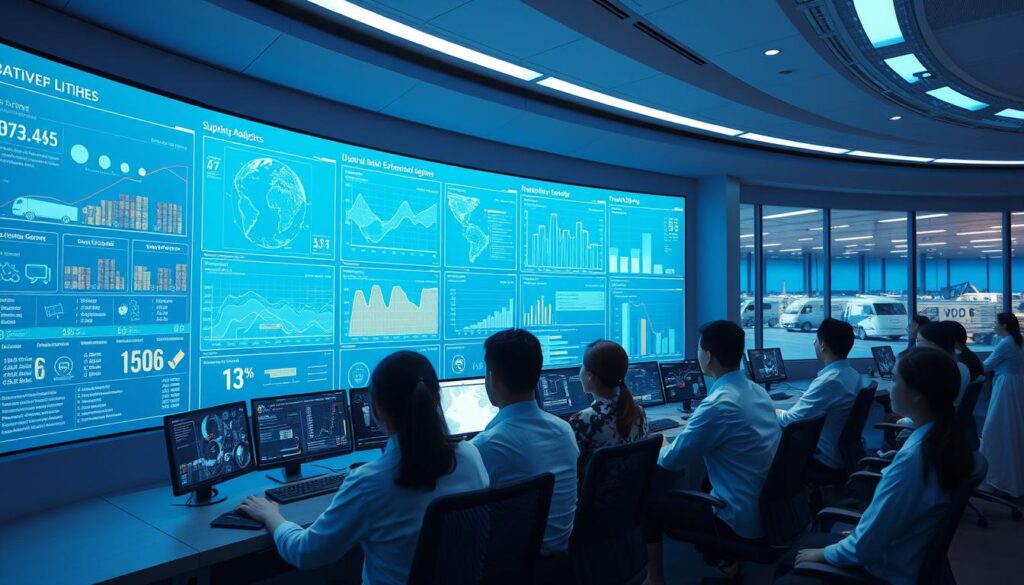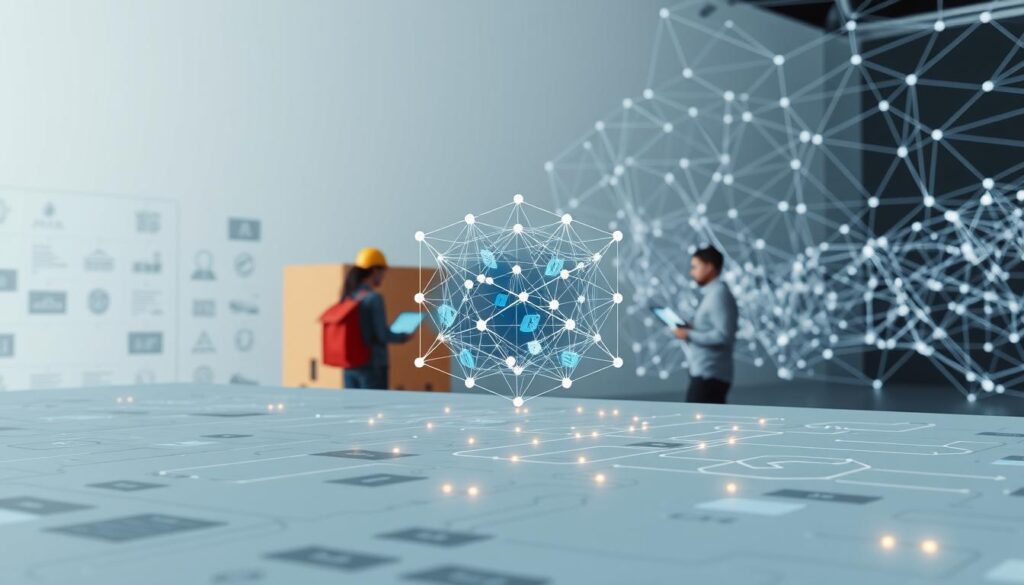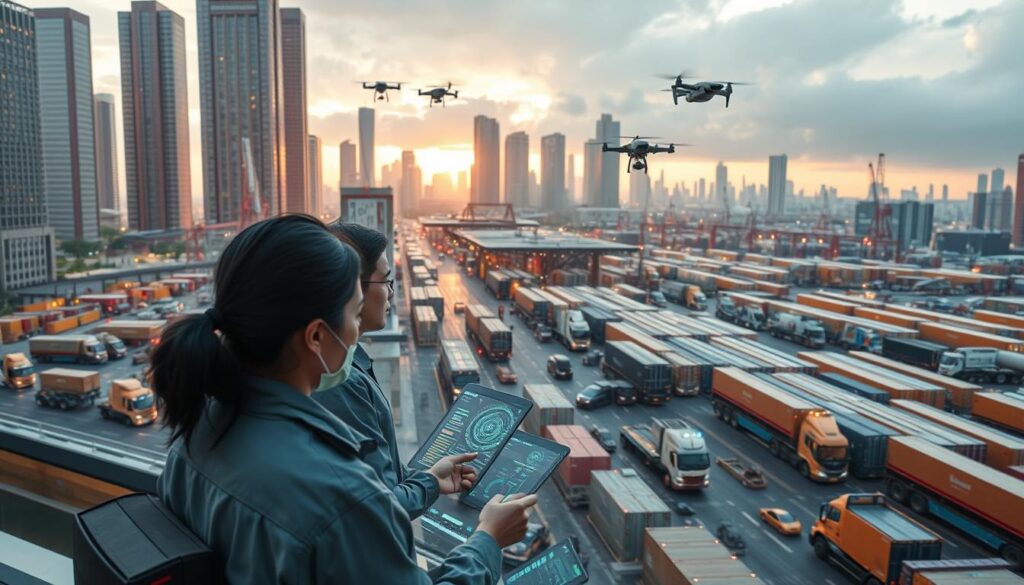Imagine if the secret to changing global supply chains was hidden in machines’ brains. By 2030, AI for logistics will change how businesses work in ways we can’t imagine yet. AI in supply chains is not just about making things automatic. It’s about making things better, cheaper, and smarter across all areas.
Companies, mainly in Southeast Asia, could see their economic impact grow to almost ₱886 trillion with AI. This article will explore the exciting future of AI in supply chains. We’ll look at its role in logistics, predictive analytics, and even global trade.
Key Takeaways
- AI is set to double the level of machine automation in supply chains within five years.
- 61% of manufacturing executives report lower costs due to AI integration.
- AI-driven tools can improve order fulfillment and reduce wastage significantly.
- Over one-third of executives predict a revenue increase exceeding 5% from AI implementation.
- AI can greatly enhance real-time decision-making in supply chain operations.
- Global spending on IIoT platforms is projected to grow exponentially in the coming years.
The Evolution of AI in Supply Chains
Artificial intelligence in supply chain management has seen a big change over the years. At first, logistics was slow and full of mistakes because of manual work. Then, technology improved, leading to the use of AI solutions.
Historical Context: From Automation to AI
Logistics started with manual tasks, making it slow and error-prone. Automation came first, making things better. Next, companies added AI to their systems, using machine learning to make things even better.
Growth of AI in Southeast Asia
Southeast Asia is now a key place for AI growth. Many businesses are using new tech to improve their work. For example, UPS uses AI to plan routes better, saving fuel and making deliveries more accurate.
Importance of AI for Logistics
AI is very important for logistics. It helps analyze data faster and improve forecasts. This means deliveries are quicker, making customers happier. Companies that use AI see big improvements in their work.
| AI Impact Area | Statistics |
|---|---|
| Businesses Seeing AI Benefits | 37% |
| Projected Contribution to Global Economy by 2030 | ₱886 trillion |
| Workload Automation Potential | 40% |
| Organizations Integrating AI | 47% |
| Logistics Cost Improvement for Early Adopters | 15% |
| Service Level Increase | 65% |
In Southeast Asia, companies are using AI to keep up with the market. They are staying ahead and working more efficiently. For more on AI advancements, check out this link.
Key Benefits of AI in Logistics
The logistics sector is moving towards more technology use. AI-driven solutions are key for better operations. They bring many benefits that change the industry.
Enhanced Efficiency and Productivity
AI makes logistics better by automating tasks. For example, it finds the best routes by checking traffic and delivery times. This makes service faster and more reliable.
AI also helps with warehouse work. It uses automated systems to cut down on manual labor and mistakes.
Increased Accuracy and Reduced Errors
AI helps predict demand with high accuracy. It looks at past data and trends to manage inventory better. This lowers the chance of running out of stock or having too much.
Keeping an eye on inventory in real-time also helps. It makes sure orders are filled correctly.
Cost Savings and Resource Optimization
Using AI in logistics saves a lot of money. It optimizes resources and improves fuel use with telematics. Companies see up to 30% better efficiency and big savings from less manual work.
Real-World AI Applications in Supply Chains
Businesses face many challenges in global trade. AI technologies are changing supply chains in big ways. They make things more efficient and change how we manage inventory and logistics.
Case Study: Alibaba’s Smart Logistics
Alibaba’s Smart Logistics uses AI to make distribution better. It uses real-time data to improve logistics and inventory management. This has cut down delivery times, getting products to customers quicker than before.
Case Study: J&T Express Innovations
J&T Express uses AI to improve package delivery. Its new methods have made deliveries over 90% accurate. This shows how AI can make logistics more efficient and competitive.
The Role of AI in Inventory Management
Good inventory management is key in global trade. AI helps by predicting what customers will buy. This lets companies adjust their stock levels, reducing mistakes and stockouts. This makes businesses more efficient and boosts their profits.
Predictive Analytics and Demand Forecasting
Predictive analytics in logistics is key to understanding what customers want and managing stock well. It uses past data to predict demand changes, helping businesses adapt to market shifts. The AI in supply chain management market is growing fast, expected to reach ₱1.28 trillion by 2030. This technology is changing many industries, but Southeast Asia is seeing the biggest changes.
Understanding Consumer Behavior
Knowing what customers want is crucial for good demand forecasting. Predictive analytics helps businesses understand buying patterns. This way, they can adjust their stock levels to meet demand, avoiding stockouts and overstock.
For example, using AI for demand forecasting has improved accuracy by 20-30% for some retailers. By 2024, 75% of supply chain organizations plan to use AI for forecasting. This makes it essential for staying ahead in the market.
Positive Impact on Inventory Levels
Predictive analytics has a big positive effect on managing stock. AI forecasting helps keep stock levels just right, cutting costs by about 35%. Walmart, for instance, has cut out-of-stocks by 16% thanks to better forecasting.
This leads to more products being available and happier customers. It makes supply chains more flexible and better at meeting customer needs.
Southeast Asian Market Trends
In Southeast Asia, the market moves fast, and inventory needs to be quick to adapt. The rise in online shopping means stock levels need to change fast. Predictive analytics helps companies predict these changes, helping them grab new opportunities.
The region is expected to see the fastest growth in AI for supply chain management. Local businesses are adopting these new tools to improve their efficiency and productivity.

| Statistic | Impact on Supply Chain |
|---|---|
| AI in supply chain management market size (2023) | ₱197 billion |
| Projected market growth (2023-2030) | CAGR of 30.3% to reach ₱1.28 trillion |
| Forecast accuracy improvement | 20-30% increase |
| Reduction in carrying costs | 35% savings for businesses |
| Reduction in out-of-stocks – Walmart | 16% decrease |
AI and Global Trade Dynamics
AI is changing global trade in big ways. It makes logistics better and helps with quick data analysis. This is making trade routes change.
AI makes things more efficient and cuts costs. It also speeds up customs checks. Businesses get insights from AI to meet market needs and keep trade smooth.
How AI Reshapes Trade Routes
AI looks at weather and traffic to find the best routes. This cuts down on travel time and fuel use. It makes trade faster and greener.
AI lets businesses track shipments in real time. They can fix problems early. AI’s speed is key for staying ahead in global trade.
The Impact on Export and Import Processes
AI makes customs work easier and faster. It cuts down on paperwork and mistakes. This helps businesses avoid fines and work better.
AI helps customs agencies handle problems fast. This keeps trade moving smoothly. AI is key for countries to grow in global markets.
Collaborations Between Countries
AI helps countries work together better. It leads to smarter trade deals and partnerships. This boosts growth across borders.
AI-driven teamwork is crucial for the future of trade. It helps countries share knowledge and resources. This is how international trade will grow.
Challenges of Integrating AI in Supply Chains
Companies face many hurdles when trying to use machine learning to improve supply chains. Employees might resist change, worried about how new tech will affect their jobs. This fear can slow down efforts to use artificial intelligence.
Data privacy and security are also big concerns. Using a lot of data can make it hard to follow rules, which might stop businesses from using AI.
Resistance to Change in Organizations
It’s hard for companies to get employees to accept new tech like machine learning. People might worry about losing their jobs or think old ways are better. To help, companies need to involve employees and teach them about the new tech.
Data Privacy and Security Concerns
Using AI means dealing with a lot of sensitive data. Companies must make sure they follow rules to protect this data. This requires strong security and a big investment in keeping data safe.
For AI to work in supply chains, companies need to focus on security. This will help build trust and keep operations safe.
Skills Gap and Workforce Training
There’s a big gap in skills when it comes to AI and machine learning. To bridge this gap, companies need to train their workers. This training should keep employees up-to-date with the latest tech.
There are many resources for training, like studies and workshops on using tech in logistics.

| Challenge | Impact | Potential Solutions |
|---|---|---|
| Resistance to Change | Hinders AI adoption and integration | Employee engagement programs, transparent communication |
| Data Privacy and Security | Increases compliance risks, reduces trust in AI systems | Robust security frameworks, regulatory compliance training |
| Skills Gap | Limits effective utilization of AI technologies | Comprehensive training programs, continuous learning opportunities |
The Role of Robotics in Supply Chain AI
Robotics and AI are changing global trade, making supply chains better. They use autonomous vehicles to improve delivery and cut costs. This change helps companies work more efficiently and save money.
Introduction to Autonomous Vehicles
Autonomous vehicles are a big step forward in supply chain robotics. They help with faster and more efficient delivery. Some have seen a 20% drop in delivery times.
As AI becomes more important, using these vehicles will be key for businesses. It helps them make their operations smoother.
Robotics Trends in Southeast Asia
Southeast Asia is seeing more robots in logistics. Companies are putting money into making warehouses more efficient. Over two-thirds of supply chain groups in the area are using AI to improve.
This trend is expected to grow. Robotics will help make things more efficient and cheaper. The AI market in supply chains could hit over ₱2.31 trillion by 2030.
Collaborations Between Tech Firms and Logistics
Partnerships between tech companies and logistics are driving AI robotics forward. These partnerships help create better automation solutions. This leads to cost savings and more precise deliveries.
For example, DHL used autonomous robots and saw a 30% boost in efficiency. These advancements show how AI is shaping global trade. They help logistics overcome challenges and grow.
Sustainability and AI in Supply Chains
As we face growing environmental concerns, using technology is key to sustainable practices. AI is crucial in making supply chains greener. It helps by making routes more efficient and managing inventory better. This leads to less waste and more productivity.
In the Philippines, businesses are starting to use AI for green goals. They’re adopting new tech to help the planet.
Reducing Carbon Footprints
Did you know that a third of all food is thrown away? This waste is a big contributor to greenhouse gases. But, AI is changing this by helping companies cut down on waste.
With AI, waste can be reduced by 10% to 40%. This is a big step towards a cleaner environment and meeting new emission rules.
The Circular Economy Approach
The circular economy is all about using resources over and over again. This means less waste and more efficiency. AI helps make this happen by improving how we predict and manage inventory.
With AI, businesses can guess their inventory needs better. This means less overstock and less food going to waste.
Local Initiatives in the Philippines
In the Philippines, startups and big companies are starting to use AI for the environment. They want to cut down on carbon emissions and follow new rules. By using AI, they’re making their businesses more eco-friendly.

The Future of AI and Supply Chain Transparency
The AI future in supply chains highlights the need for clear logistics. Technology’s growth means we can see how supply chains work better. This helps businesses quickly adapt to market changes.
Companies are now using new ways to be more open about their operations. This is a big step towards better supply chain management.
Importance of Visibility in Logistics
Knowing what’s happening in the supply chain is key. It lets companies track every step. This way, they can:
- Build trust with customers by sharing information.
- Manage stock better by guessing demand right.
- Find and fix problems fast to avoid delays.
By 2024, half of supply chain groups will use AI and analytics. This means better decisions and improved performance.
Blockchain and AI Integration
Using blockchain with AI could change how we see supply chains. Blockchain keeps records safe and accurate. With AI, it helps track goods live. This leads to:
- Better tracking of products.
- Stronger data safety.
- Easier following of rules.
This tech combo could cut down on emissions and make workflows better. It’s a big step towards a future with AI in supply chains.
Regional Standards for Transparency
Setting standards for supply chain openness is important. It helps keep practices high across markets. These standards help businesses:
- Match up with global standards.
- Make trade easier by building trust.
- Work better together in complex chains.
As the gap between businesses grows, meeting these standards is crucial. It ensures fair access to resources and chances in the AI world.
Collaboration and AI in Supply Chains
Collaboration is key in using AI for logistics by 2030. Big companies and new startups are teaming up. They create solutions that meet different needs in the market.
Together, they share resources, know-how, and tech. This helps improve how goods move from one place to another.
Partnerships Between Enterprises
Big companies are seeing the value in working with smaller, quick startups. These startups bring fresh ideas and new tech. This mix leads to creative AI solutions for logistics.
By teaming up, businesses can work better. This is good for their growth, matching the AI for logistics 2030 sector’s expected rise.
Role of Startups in Innovating AI Solutions
Startups lead in making logistics better with AI. They can quickly try new things and adapt. This lets them come up with smart ways to manage stock and predict demand.
When they team up with big companies, startups can make their ideas bigger. This helps make processes better and cheaper. It’s a big deal for the future of logistics and AI.
Government Support and Initiatives
Governments in Southeast Asia are helping with AI in logistics. They’re working with private companies to make AI part of supply chains. This includes giving tech and resources to businesses.
This support lets companies be more innovative. It helps them work more efficiently. It’s a step towards making AI in logistics a reality by 2030.

Preparing for the Future of AI in Supply Chains
As supply chains change, leaders must plan ahead for AI. They should look for ways to make things more efficient, cut costs, and please customers. AI can make logistics better, helping companies meet demand faster and predict sales more accurately.
Those who invest in AI will likely stay ahead of the competition. The industry is always evolving, and being ready is key.
Strategies for Business Leaders
Leaders should make AI a key part of their logistics plans. They should also keep learning and adapting. This helps teams handle new tech smoothly.
Training employees on AI is crucial. It prepares them for the challenges and chances that new tech brings.
Emphasizing Continuous Learning and Adaptation
Keeping up with AI changes is essential. As automation grows, teams need to be flexible. Training programs and workshops can help teams thrive in a tech world.
This ensures they’re ready for the AI future in supply chains.
Role of AI Investment in Growth
AI investment can make logistics better and boost growth. Companies using AI see fewer mistakes and more money. With the right investment, they can lead the market and meet today’s supply chain needs.

